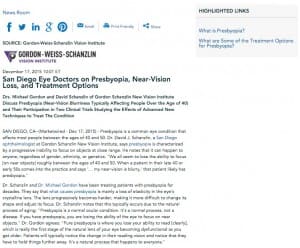
Drs. Michael Gordon and David Schanzlin of Gordon Schanzlin New Vision Institute discuss presbyopia (near-vision blurriness typically affecting people over the age of 40) and their participation in two clinical trials studying the effects of advanced new techniques to treat the condition.
San Diego, CA – Presbyopia is a common eye condition that affects most people between the ages of 40 and 50. Dr. David J. Schanzlin, a San Diego ophthalmologist at Gordon Schanzlin New Vision Institute, says presbyopia is characterized by a progressive inability to focus on objects at close range. He notes that it can happen to anyone, regardless of gender, ethnicity, or genetics. “We all seem to lose the ability to focus [on near objects] roughly between the ages of 40 and 50. When a patient in their late 40 or early 50s comes into the practice and says ‘… my near-vision is blurry,’ that patient likely has presbyopia.”
Dr. Schanzlin and Dr. Michael Gordon have been treating patients with presbyopia for decades. They say that what causes presbyopia is mainly a loss of elasticity in the eye’s crystalline lens. The lens progressively becomes harder, making it more difficult to change its shape and adjust its focus. Dr. Schanzlin notes that this typically occurs due to the natural process of aging: “Presbyopia is a normal ocular condition. It’s a normal process, not a disease. If you have presbyopia, you are losing the ability of the eye to focus on near objects.” Dr. Gordon agrees: “Pure presbyopia is where you lose your ability to read [clearly], which is really the first stage of the natural lens of your eye becoming dysfunctional as you get older. Patients will typically notice the change in their reading vision and notice that they have to hold things further away. It’s a natural process that happens to everyone.”
While the doctors say that bifocals and reading glasses are some of the most common solutions for the condition, there are a number of available surgical treatments for presbyopia that can improve a patient’s near-vision and reduce the need for corrective eyewear. One of these treatments, says Dr. Gordon, is LASIK Monovision, which is a laser vision correction procedure designed to correct one eye for far-distance vision and the other for near-distance vision. When the brain processes the image, it blends them together for a clear result. “Your brain just sees what you’re looking at even though the images may be different from the two eyes. I’ve been performing Monovision procedures for many years and I’ve found that it works extremely well.”
Dr. Schanzlin says another treatment option that’s proven successful for presbyopia is the intraocular lens (IOL). This procedure removes the eye’s crystalline lens and replaces it with a lens implant designed to improve the patient’s vision. He notes that not all treatment options are ideal for every patient, and one person may benefit more from a certain procedure than another individual. “At our office we will talk to you about available options to improve the symptoms of presbyopia and determine the best treatment approach based on your unique visual needs.”
While the doctors say that laser vision correction and lens implantation have often proven highly successful, research into even more promising treatments for presbyopia continues unabated. In fact, both Dr. Gordon and Dr. Schanzlin are involved in two separate clinical trials for potential new presbyopia treatment techniques. Dr. Gordon is participating in the Presbia Flexivue Microlens™ study, which is a reversible procedure that implants a very thin lens into the eye. “The beauty of this lens is that it’s extremely well-tolerated by the eye – it’s a material that has been used for decades. You can change the [focusing] power of the lens – in other words, you can give it a power that’s dependent on what the patient actually needs as opposed to a one-power-fits-all solution. Early results of the clinical trials are extremely promising.” Dr. Schanzlin is working on the Refocus VisAbility™ Implant System Study, which places small inserts into the eye to help restore the elasticity of lax ligaments. The procedure is designed to ultimately renew the mobility of the lens and the eye’s ability to focus.
Both doctors believe that current treatments for presbyopia and the potential for new solutions in the future make it a very exciting time in the field of ophthalmology, and make it less likely that the effects of this most common condition have a significant impact on a person’s vision and lifestyle.
About Michael Gordon, M.D.
Dr. Michael Gordon has more than 25 years of experience as a laser eye surgeon and ophthalmologist. Certified by the American Board of Ophthalmology, Dr. Gordon is a founding board member of the International LASIK Institute. He is a member of the American Academy of Ophthalmology, the International Society for Refractive Surgery, and many other respected medical organizations. Among many career distinctions, Dr. Gordon has been recognized with the American Academy of Ophthalmology’s Achievement Award. He is available for interview upon request.
About Dr. David J. Schanzlin, M.D.
Dr. David Schanzlin has been one of the leading practitioners of keratorefractive surgery for more than 32 years. A former President of the International Society of Refractive Surgery, Dr. Schanzlin is known as a global authority on refractive surgery and has been recognized numerous times as one of the Best Doctors in America®. A graduate of the University of Chicago, Pritzker School of Medicine, Dr. Schanzlin has dedicated his career to developing advanced procedures for the treatment of an array of eye diseases and conditions. He is available for interview upon request.
For more information, please visit gwsvision.com and facebook.com/lasiksandiego.
Contact:
Gordon Schanzlin New Vision Institute
8910 University Center Lane
Ste. 800
La Jolla, San Diego, CA 92122
(858) 455-6800

